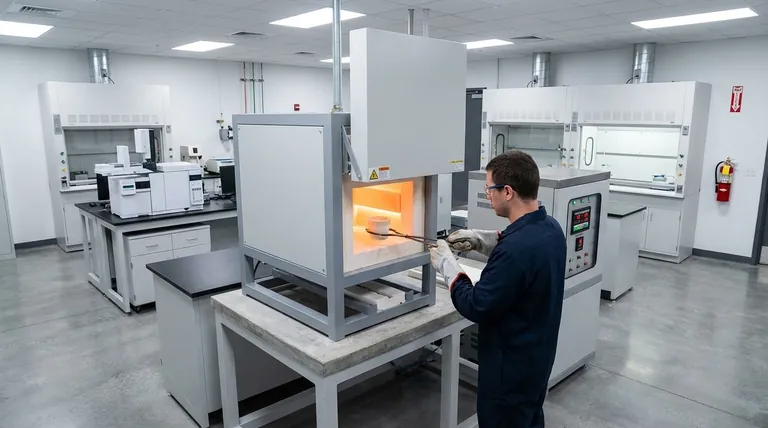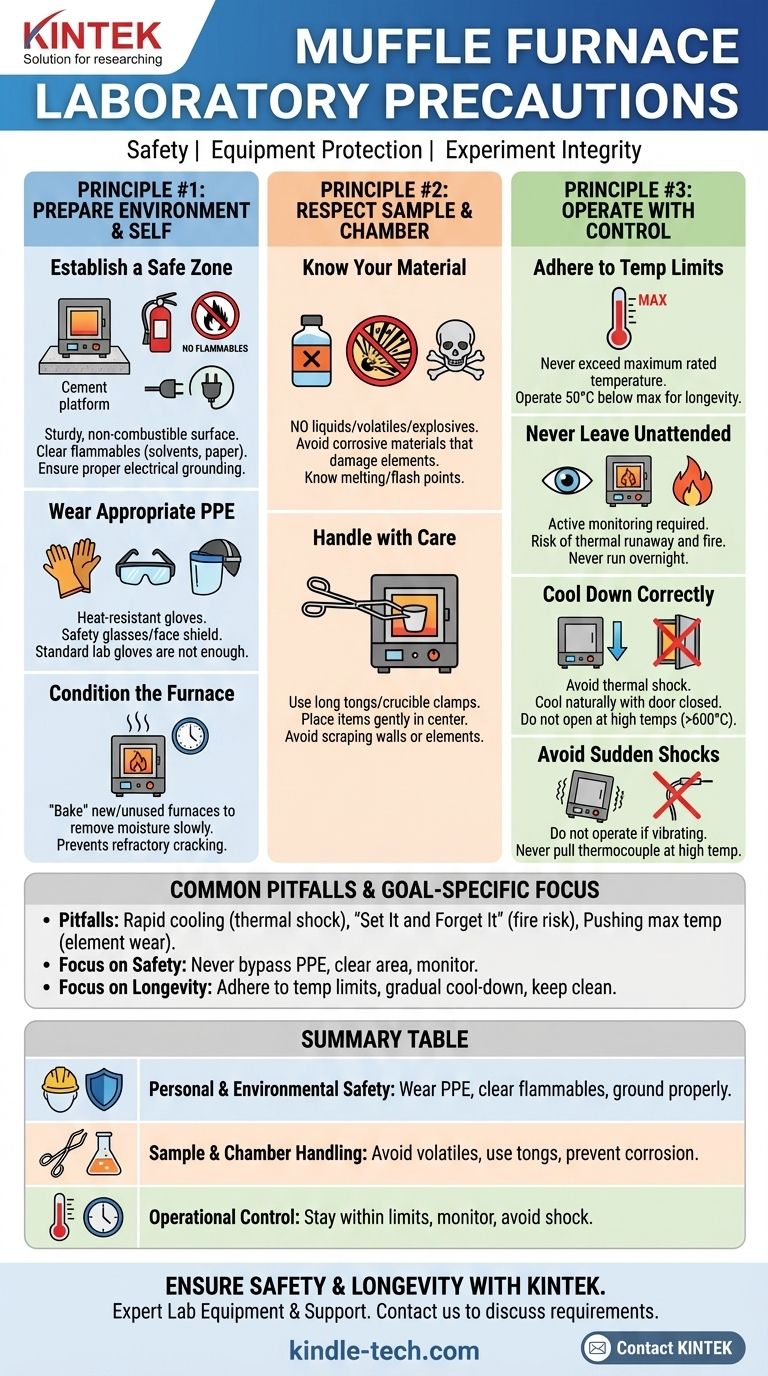Наиболее важные меры предосторожности при использовании муфельной печи делятся на три категории: предотвращение травм персонала, защита оборудования от повреждений и обеспечение целостности вашего эксперимента. Это не просто правила, которым нужно следовать, а принципы, которые нужно понимать, поскольку их несоблюдение может привести к серьезным ожогам, выходу оборудования из строя, пожару или порче образцов.
Муфельная печь — это прецизионный инструмент, а не просто духовка. Ее безопасная и эффективная работа зависит от систематического подхода, который начинается до включения питания и заканчивается спустя долгое время после ее остывания.

Принцип №1: Подготовьте свое окружение и себя
Прежде чем вы даже подумаете о нагреве образца, вы должны убедиться, что основа для безопасности заложена. Это включает в себя обеспечение безопасности физического пространства и надлежащее оснащение оператора.
Создайте безопасную зону
Муфельная печь генерирует экстремальное внешнее тепло и требует значительной электрической мощности. Она должна быть размещена на прочной, ровной и негорючей поверхности, такой как специальная цементная платформа.
Окружающая территория должна быть полностью свободна от легковоспламеняющихся и горючих материалов. Это включает растворители, бумагу и чистящие салфетки.
Убедитесь, что печь подключена к электрической цепи с соответствующим номиналом, с правильными вилками, розетками и предохранителями. Правильное заземление является обязательным для предотвращения поражения электрическим током.
Используйте соответствующие средства индивидуальной защиты (СИЗ)
Риск получения серьезных термических ожогов высок. Всегда надевайте термостойкие перчатки и защитные очки или лицевой щиток при работе с предметами, которые помещаются в печь или извлекаются из нее.
Тип перчаток должен соответствовать рабочей температуре. Стандартные лабораторные перчатки не обеспечивают защиты от лучистого тепла открытой дверцы печи.
Подготовьте печь перед использованием
Если печь новая или не использовалась в течение длительного периода, она могла впитать влагу в свою огнеупорную футеровку. Эту влагу необходимо медленно удалить, чтобы предотвратить повреждение.
Это делается путем «прокаливания» печи: нагревания ее при низкой температуре в течение нескольких часов с последующим постепенным повышением температуры. Невыполнение этого может привести к быстрому расширению пара внутри огнеупорного материала, что приведет к трещинам.
Принцип №2: Уважайте образец и камеру
То, что вы помещаете внутрь печи, и то, как вы это делаете, напрямую влияет на безопасность и срок службы оборудования.
Знайте свой материал
Никогда не помещайте жидкости, летучие вещества или взрывчатые материалы в камеру печи. Быстрый нагрев может вызвать неконтролируемое испарение или воспламенение.
Образцы, содержащие жиры, масла или некоторые пластмассы, могут выделять коррозионные газы при нагревании. Эти газы будут атаковать и разрушать поверхность нагревательных элементов, резко сокращая их срок службы. Если вы должны нагревать такие материалы, используйте герметичный контейнер с надлежащей вентиляцией.
Знайте точки плавления и вспышки всего, что вы помещаете внутрь камеры, чтобы предотвратить неожиданные реакции.
Обращайтесь осторожно
Всегда используйте длинные щипцы или тигли для загрузки и выгрузки образцов. Это держит ваши руки подальше от интенсивного тепла.
Аккуратно помещайте предметы в центр камеры. Падение или царапание предметов о стенки камеры или нагревательные элементы может привести к немедленному и дорогостоящему повреждению.
Принцип №3: Работайте с преднамеренным контролем
Муфельная печь — это не устройство типа «установил и забыл». Она требует активного мониторинга и дисциплинированной последовательности операций.
Соблюдайте температурные ограничения
Никогда не эксплуатируйте печь выше ее максимальной номинальной температуры. Это приведет к перегоранию нагревательных элементов и может вызвать катастрофический отказ.
Для обычного использования и для максимального увеличения срока службы нагревательных элементов рекомендуется работать как минимум на 50°C ниже максимальной температуры.
Никогда не оставляйте без присмотра
Работающая печь должна находиться под наблюдением. Системы управления могут выйти из строя, а термопары могут работать неправильно, что приводит к ситуации теплового разгона, создающей значительную пожарную опасность. Никогда не оставляйте печь без присмотра на ночь.
Если вы заметите какие-либо отклонения, такие как необычные шумы, дым или показания температуры, не соответствующие заданной точке, немедленно отключите питание и проверьте устройство.
Правильно охлаждайте
Никогда не открывайте дверцу печи при высоких температурах (например, выше 600°C), чтобы быстрее охладить ее. Внезапный приток холодного воздуха создает термический шок, который может привести к растрескиванию огнеупорной футеровки печи и потенциально разрушить ваш образец.
Всегда отключайте питание и позволяйте печи остывать естественным образом с закрытой дверцей.
Избегайте внезапных ударов
Не используйте печь, если она вибрирует. Что еще более важно, никогда не вытягивайте термопару из ее порта, когда печь находится при высокой температуре. Быстрое изменение температуры может привести к разрушению защитной керамической оболочки.
Понимание распространенных ошибок
Новые пользователи часто поддаются искушению сократить путь, что ставит под угрозу безопасность и долговечность оборудования ради скорости.
Искушение быстрого охлаждения
Желание быстро получить доступ к образцу велико, но открытие дверцы горячей печи — один из самых распространенных способов вызвать необратимые повреждения. Сэкономленное время не стоит затрат на замену футеровки печи.
Заблуждение «установил и забыл»
Отношение к печи как к бытовой духовке — это критическая ошибка. Ее мощность и температурные возможности требуют уважения. Простой отказ контроллера может превратить оставленную без присмотра печь в неконтролируемый источник огня.
Работа на максимальной температуре
Хотя печь рассчитана на максимальную температуру, постоянная работа на этом пределе подобна работе двигателя автомобиля на красной линии. Это резко ускоряет износ наиболее важных компонентов — нагревательных элементов.
Применение этих мер предосторожности к вашей цели
Ваши конкретные приоритеты будут определять, каким мерам предосторожности следует уделить наибольшее внимание.
- Если ваша основная цель — безопасность оператора: Никогда не пренебрегайте СИЗ, всегда убеждайтесь, что территория свободна от легковоспламеняющихся материалов, и никогда не оставляйте печь без присмотра.
- Если ваша основная цель — долговечность оборудования: Строго соблюдайте температурные ограничения, всегда выполняйте постепенное охлаждение и поддерживайте чистоту камеры от коррозионных остатков.
- Если ваша основная цель — точность эксперимента: Всегда подготавливайте новую или давно неиспользовавшуюся печь для удаления влаги и убедитесь, что ваши образцы свободны от загрязняющих веществ, которые могут выделять газы и мешать процессу.
Овладение использованием муфельной печи достигается дисциплиной и глубоким уважением к ее мощности.
Сводная таблица:
| Категория мер предосторожности | Основные действия |
|---|---|
| Личная и экологическая безопасность | Используйте термостойкие СИЗ, убирайте легковоспламеняющиеся материалы, обеспечивайте надлежащее заземление. |
| Обращение с образцами и камерой | Избегайте летучих материалов, используйте правильные щипцы, предотвращайте выделение коррозионных газов. |
| Операционный контроль | Никогда не превышайте температурные пределы, избегайте работы без присмотра, предотвращайте термический шок во время охлаждения. |
Обеспечьте безопасность и долговечность вашего лабораторного оборудования. Правильное использование муфельной печи имеет решающее значение для защиты вашего персонала и целостности ваших исследований. KINTEK специализируется на высококачественном лабораторном оборудовании и расходных материалах, удовлетворяя все потребности вашей лаборатории. Наши эксперты помогут вам выбрать подходящую печь и понять лучшие практики безопасной эксплуатации.
Свяжитесь с KINTEK сегодня, чтобы обсудить ваши конкретные требования и обеспечить безопасную и эффективную работу вашей лаборатории.
Визуальное руководство

Связанные товары
- Лабораторная муфельная печь с нижним подъемом
- Муфельная печь 1400℃ для лаборатории
- Муфельная печь 1700℃ для лаборатории
- Муфельная печь 1800℃ для лаборатории
- Лабораторная кварцевая трубчатая печь 1400℃ с трубчатой печью с глиноземной трубой
Люди также спрашивают
- Влияет ли теплоемкость на температуру плавления? Разбираем ключевые различия в тепловых свойствах
- Какова разница между муфельной печью и сушильным шкафом с принудительной циркуляцией воздуха? Выберите правильный нагревательный прибор для вашей лаборатории
- Могут ли два разных материала иметь одинаковое значение удельной теплоемкости? Раскрывая науку о термическом поведении
- Каков механизм нагрева муфельной печи? Добейтесь точного нагрева без загрязнений
- Для чего используется муфельная печь? Достижение высокотемпературной обработки без загрязнений



















